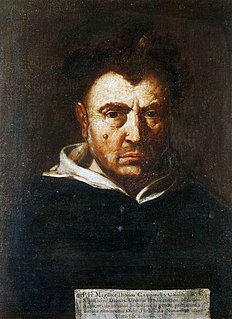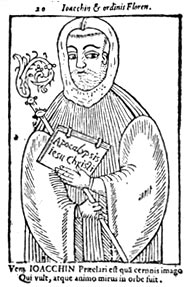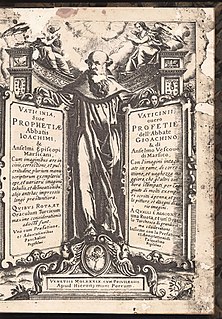
Michel de Nostredame, usually Latinised as Nostradamus, was a French astrologer, physician and reputed seer, who is best known for his book Les Prophéties, a collection of 942 poetic quatrains allegedly predicting future events. The book was first published in 1555.

Pope Pius IV, born Giovanni Angelo Medici, was head of the Catholic Church and ruler of the Papal States from 25 December 1559 to his death in 1565. Born in Milan, his family considered itself a branch of the House of Medici and used the same coat of arms. Although modern historians have found no proof of this connection, the Medici of Florence recognized the claims of the Medici of Milan in the early 16th century.

The 1500s ran from January 1, 1500, to December 31, 1599.

Girolamo Savonarola was an Italian Dominican friar from Ferrara and preacher active in Renaissance Florence. He was known for his prophecies of civic glory, the destruction of secular art and culture, and his calls for Christian renewal. He denounced clerical corruption, despotic rule, and the exploitation of the poor. He prophesied the coming of a biblical flood and a new Cyrus from the north who would reform the Church.

Tommaso Campanella, baptized Giovanni Domenico Campanella, was an Italian Dominican friar, philosopher, theologian, astrologer, and poet.

Francesco Totti is an Italian former professional footballer who played solely for Roma and the Italy national team primarily as an attacking midfielder or second striker, but could also play as a lone striker or winger. He is often referred to as Er Bimbo de Oro, L'Ottavo Re di Roma, Er Pupone, Il Capitano, and Il Gladiatore by the Italian sports media. A creative offensive playmaker renowned for his vision, technique, and goalscoring ability, Totti is considered to be one of the greatest Italian players of all time and Roma's greatest player ever.

Joachim of Fiore, also known as Joachim of Flora and in Italian Gioacchino da Fiore, was an Italian Christian theologian, Catholic abbot, and the founder of the monastic order of San Giovanni in Fiore. According to theologian Bernard McGinn, "Joachim of Fiore is the most important apocalyptic thinker of the whole medieval period."

The Prophecy of the Popes is a series of 112 short, cryptic phrases in Latin which purport to predict the Roman Catholic popes, beginning with Celestine II. It was first published in 1595 by Benedictine monk Arnold Wion, who attributed the prophecy to Saint Malachy, a 12th-century archbishop of Armagh.
The Muggletonians, named after Lodowicke Muggleton, were a small Protestant Christian movement which began in 1651 when two London tailors announced they were the last prophets foretold in the biblical Book of Revelation. The group grew out of the Ranters and in opposition to the Quakers. Muggletonian beliefs include a hostility to philosophical reason, a scriptural understanding of how the universe works and a belief that God appeared directly on Earth as Jesus Christ. A consequential belief is that God takes no notice of everyday events on Earth and will not generally intervene until it is meant to bring the world to an end.

The Tree of Jesse is a depiction in art of the ancestors of Jesus Christ, shown in a branching tree which rises from Jesse of Bethlehem, the father of King David. It is the original use of the family tree as a schematic representation of a genealogy.

The Roman Catholic Archdiocese of Turin is an ecclesiastical territory or diocese of the Roman Catholic Church in Italy.

Cesare Cremonini, sometimes Cesare Cremonino, was an Italian professor of natural philosophy, working rationalism and Aristotelian materialism inside scholasticism. His Latinized name was Cæsar Cremoninus. or Cæsar Cremonius.

A series of manuscript prophecies concerning the Papacy, under the title of Vaticinia de Summis Pontificibus, a Latin text which assembles portraits of popes and prophecies related to them, circulated from the late thirteenth-early fourteenth century, with prophecies concerning popes from Pope Nicholas III onwards.
The Prophecies of the Nun of Dresden, under the original Italian title of Le profezie della monaca di Dresda, is a novel by Renzo Baschera which takes the form of an essay analyzing several manuscripts purportedly found at the beginning of the 19th century. These manuscripts contain prophecies about the last Popes, the great European dynasties, technological progress, several disasters and the end of time, from the end of the 17th century to the end of the 30th century.
Telesphorus of Cosenza was a name assumed by one of the pseudo-prophets during the time of the Western Schism. As an pseudonymous author of a Latin work Liber de magnis tribulationibus, the name was attached to a 1365 production of the Fraticelli. The Liber was updated to fit the situation in the Schism.
Roger Frontenac was a French navy officer and a scholar of Nostradamus' prophecies. He proposed an interpretation system for the text of Les Propheties, based upon a form of cryptography known as the Vigenère table.

The Blessed Virgin Mary has been one of the major subjects of Western Art for centuries. Numerous pieces of Marian art in the Catholic Church covering a range of topics have been produced, from masters such as Michelangelo and Botticelli to works made by unknown peasant artisans.
Jacopo Brocardo was an Italian Protestant convert and biblical interpreter. He regarded the year 1584 as the inauguration of a major new cycle. He prophesied that the last age would last 120 years from the birth of Martin Luther in 1483. As an apocalyptic thinker he was influenced by Martin Cellarius.
James Maxwell was a Scottish scholar, known as an author on mythology and prophecy. Most of his works are lost. He advocated for the view that the House of Stuart would found the Last World Empire of prophetic tradition.
Alexander of Roes was the dean of St. Maria im Kapitol, Cologne, canon law jurist, and author on history and prophecy. He was a member of a patrician Cologne family and was a member of the social group in Rome headed by Cardinal Jacobus de Columna, to whom he dedicated Memoriale...


















